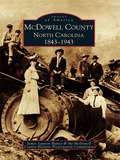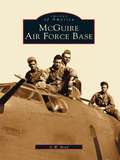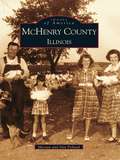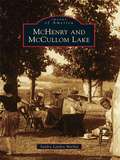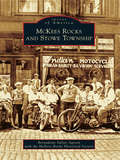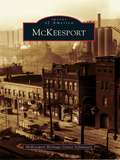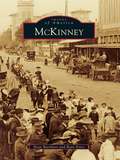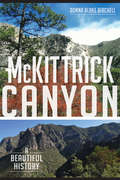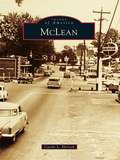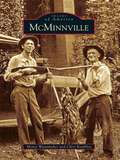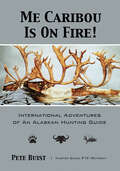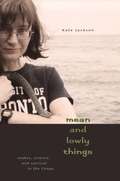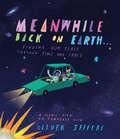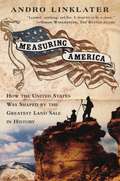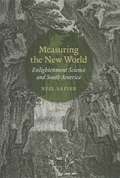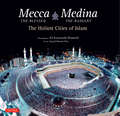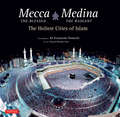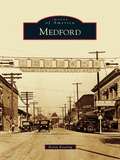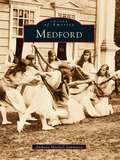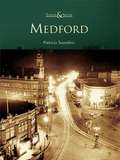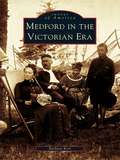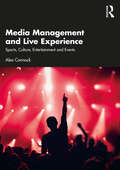- Table View
- List View
McDowell County, North Carolina 1843-1943
by James Lawton Haney McDowell County Historic Preservation CommissionMcDowell County is unique culturally and topographically. Formed by legislative action in 1842 from Burke and Rutherford Counties, McDowell's northern and western borders trace the towering heights and rugged terrain of the Blue Ridge, while its eastern and southern borders incorporate broad river bottoms and lower hills of the Piedmont. Showcasing more than 220 images, this volume is a mosaic of McDowell County's first century and covers the towns of Marion and Old Fort, as well as smaller communities like Brackettown, Crooked Creek, Dyartsville, Glenwood, Greenlee, Little Switzerland, Montford's Cove, Nebo, and North Cove. Views of waterfalls on the Catawba River and Tom's Creek, along with those of the eerie limestone formations of Linville Caverns, attest to nature's bounty. Aging photographs, many of which are published for the first time, draw attention to families, churches, schools, memorable personalities, and historic sites. This collection also brings to life the county's defining events: the arduous construction of two railways through the mountains, the destruction of Marion by fire in 1894, the disastrous flood of 1916, the textile strike of 1929, and the patriotic response by the citizenry to national crises. Photographs of selected homes, commercial sites, churches, and schools testify to the diverse architectural style and levels of economic and social well-being found in the county.
McGraw-Hill Reading 1, Book 4
by Angela Shelf Medearis Jan E. Hasbrouck James Flood Diane Lapp Josefina Villamil Tinajero Karen D. Wood James V. Hoffman Scott Paris Steven StahlA textbook that helps children improve their reading skills by use of poems, play, stories and comprehension passages.
McGuire Air Force Base (Images of America)
by G. W. BoydMcGuire Air Force Base, built on property ceded by the Boy Scouts of America, the Civilian Conservation Corps, and the contiguous Fort Dix, has served the nation proudly for decades. Originally, it was intended to be used as a home for observation antisubmarine reconnaissance aircraft and army support as Fort Dix Army Air Field, but the focus of the base quickly changed as a result of its strategic location. McGuire Air Force Base recounts the contributions of this military asset with more than two hundred photographs from the archives of the U.S. Air Force and the U.S. Army. Among its many achievements, McGuire was the first American military base to become operational with the F-106 Delta Dart; the first base to operate an all-jet military transport, the C-135 Stratolifter; and finally, the first base to become operational with a ground-launched antiaircraft nuclear missile squadron. In the 1950s, McGuire became the air force's principal aerial port on the East Coast-a role it continues to this day.
McHenry County, Illinois
by Dan Pelland Maryan PellandMcHenry County, Illinois, is a picture-perfect farming community in the Heartland of Midwestern America. For nearly two centuries, a portion of the nation's food supply has come from this fertile land near the Fox River, and it has played a key role in the history of Chicago and the United States. Through the medium of historic photographs, this book captures the evolution of the people of McHenry County, from the mid-1800s to the second half of the twentieth century.These pages bring to life the people, events, communities, and industries that helped shape and transform McHenry County. With more than 200 vintage images, culled from three collections-the McHenry County Historical Society, the Crystal Lake Historical Society, the James Keefe Collection, and the personal collection of Don Peasley-McHenry County, Illinois, portrays life against a backdrop of international wars, national social struggles, and technological advances in an expanding world.
McHenry and McCullom Lake
by Sandra Landen MachajCome along to McHenry. Nestled between the Fox River and McCullom Lake, it is a friendly, welcoming city with a rich history. It was designated as the first county seat of the newly formed McHenry County in 1837. Its surrounding farmland provided both food from its crops and milk from its cows to the Chicagoarea. Diverse businesses such as boatbuilders, ice cutters, lumber companies, flour mills, brick makers, and cigar makers chose to make McHenry their home. It is a unique city that grew as three separate business districts: along the river, along the railroad, and one in between. Known as the gateway to the Chain of Lakes, tourism thrived in the early 1900s as visitors from Chicago made McHenrytheir recreational destination. In McHenry and McCullom Lake, one will meet the people who helped change McHenry from a collection of log cabins on theriverfront to a bustling city with a population of 24,000.
McKees Rocks and Stowe Township (Images of America)
by McKees Rocks Historical Society Bernadette Sulzer AgreenMcKees Rocks and Stowe Township, just downriver from the Point of Pittsburgh, contributed significantly to the growth of steel and transportation in western Pennsylvania. In 1888, the Pittsburgh and Lake Erie Railroad, known as the "Little Giant," built a 100-acre maintenance facility in McKees Rocks, igniting the spark to the region's massive industrial, business, and population explosion. By 1910, the population soared to 15,000, fueled by the rapid influx of nearly 6,000 immigrants. A landmark event in labor history occurred in July 1909, when 5,000 foreign workers, representing 16 different nationalities, waged a long and bloody strike against the Pressed Steel Car Company. McKees Rocks and Stowe Township showcases a region whose diverse history includes the largest Native American mound in Pennsylvania, visits by George Washington, floods, and even Al Capone. Today a rich mix of ethnic cultures still flavors the local neighborhoods, and the accomplishments of homegrown businessmen, musicians, clergy, athletes, public servants, artists, and educators are recognized and respected throughout western Pennsylvania and beyond.
McKeesport
by McKeesport Heritage Center VolunteersLocated at the confluence of the Youghiogheny and Monongahela Rivers, McKeesport was settled by David McKee in 1755. In 1769, McKee acquired land from the Colonial government and one of his sons, John, laid out a village that became known as McKee's Port because a ferry was operating there. Early industries included coal mining and the building of flatboats, and in 1851, an ironrolling mill was started. Industry continued to boom as steamboats and railroads soon appeared, and in 1872, National Tube was founded and joined by other steel industries and foundries. The growing industries created an abundance of jobs, and immigrants from throughout Europe flocked to the area. McKeesport still maintains a strong ethnic heritage. Through vintage photographs, McKeesport documents the history of this once booming steel town from the development and subsequent loss of its major industry to its recent revitalization.
McKinney
by Ryan Estes Ryan BarnhartMcKinney's very first settlers began arriving from Kentucky, Arkansas, and Tennessee in the early 1840s. Collin County was created by the Texas legislature on April 3, 1846, and due to a provision violation requiring the county seat to be within 3 miles of the center of the county, McKinney replaced Buckner as the seat in 1848. The vote deciding the new seat, however, went in McKinney's favor primarily because flooding kept many citizens from casting ballots. On March 16, 1848, the state legislature passed an act to name the new town in honor of Collin McKinney, one of five original draftees of the Texas Declaration of Independence. Today McKinney is one of America's fastest growing cities and has seen a population boom from approximately 16,000 residents in 1985 to more than 120,000 in 2010.
McKittrick Canyon: A Beautiful History (Natural History)
by Donna Blake BirchellThe Guadalupe Mountains hold what some call the most beautiful spot in Texas. Once home to the Mescalero Apaches, McKittrick Canyon is an alluring wonderland of lush and abundant flora and fauna. It is named for Captain Felix McKittrick, who acquired the land for ranching in 1869. Legends of lost Spanish gold mines drew many unsuccessful prospectors before the turn of the century. Later, through the monumental efforts of early landowners J.C. Hunter Sr. and Wallace Pratt, the canyon was preserved as a pristine portion of the Guadalupe Mountains National Park. Each fall, eager visitors witness a vibrant show headlined by bigtooth maple and a variety of oak trees. Join author Donna Blake Birchell in an exploration of McKittrick Canyon's colorful history.
McLean (Images of America)
by Carole L. HerrickMcLean was a farming community in 1910, when Henry Alonzo Storm established a general store that included the McLean Post Office; the opening of Storm's Store is considered McLean's unofficial beginning. The store was located on Chain Bridge Road beside a stop on the Great Falls and Old Dominion Railroad, an electrified trolley that ran from Rosslyn to Great Falls Park. The stop was named after John R. McLean, a founder of the trolley and owner of the Washington Post newspaper. A village and vibrant community gradually developed around Storm's Store. The Franklin Sherman School, the first consolidated public school in Fairfax County, opened near the store in October 1914; McLean Day, the first event of its kind in the county, started in 1915 to raise money for the school; and the McLean Volunteer Fire Department incorporated in 1923 as Station 1 in Fairfax County.
McMinnville
by Monty Wanamaker Chris KeathleyLying at the western base of the Cumberland Table Land, the Middle Tennessee country in which McMinnville was situated in 1810 was generally referred to as the "Mountain District" and the town as the "Mountain City." Since its height is several hundred feet above Nashville and the counties of the basin, the town has enjoyed the distinction of the cool mountain air along with the fertility of its surrounding valleys. McMinnville, the county seat of Warren County, is presented here by its authors in an assemblage of images commemorating its 200-year history. The images are selected primarily from the authors' archives, augmented by selections from the Tennessee State Library and Archives in Nashville.
Me Caribou Is On Fire: International Adventures of An Alaskan Hunting Guide
by Pete BuistMe Caribou Is On Fire is a great read! One can almost taste the camp grub he describes, whether prepared for or by him, smell the scents of the hunting camps and cabins and feel the bitter cold of the 1992 fall hunt or the Delta sheep hunt snowstorm. The descriptions of his many hunting experiences make the reader feel like they were there with him in the wild or on a flight to the next adventure. I can't wait for the sequel! Mike Fleagle, Former Chairman - Alaska Board of Game Pete Buist is undoubtedly the epitome of the outdoorsman in the truest meaning of the term. Trapper, hunter, master guide, firefighter are just some of his accomplishments; in a nutshell, a lifetime of adventure and excitement lived in the manner that makes me envious and at the same time filled with admiration. While guiding Pete in South Africa, it did cross my mind that I would have relished doing a hunt with our roles reversed and basking in the experience of a life well-lived. Pete Tumkulu "Buist has applied his knowledge, experience, and eloquence to add the title of Author to his other accomplishments and has produced a well-written, enjoyable read capable of transporting the reader to those wild places. John" Madala" Barnes Professional Hunter - South Africa The real "trophies" of a life spent outdoors are the stories. Indeed, storytelling is a foundational skill of the seasoned hunter, and Pete's "seasoning" reaches into a stratosphere most of us will never see. I became friends with Pete in 2008, and after only a couple of days of immersing myself in his storytelling prowess, I said, "Pete, you really need to write a book." And here it is. Pete's recall, precise detail, wit, and humor are extraordinary as he takes you along on countless adventures. These entertaining stories are definitely worth the price of admission. Curt Wells Editor - Bowhunter Magazine"
Mean and Lowly Things: Snakes, Science, and Survival in the Congo
by Kate JacksonIn 2005 Kate Jackson ventured into the remote swamp forests of the northern Congo to collect reptiles and amphibians. Her camping equipment was rudimentary, her knowledge of Congolese customs even more so. She knew how to string a net and set a pitfall trap, but she never imagined the physical and cultural difficulties that awaited her. Culled from the mud-spattered pages of her journals, Mean and Lowly Things reads like a fast-paced adventure story. It is Jackson’s unvarnished account of her research on the front lines of the global biodiversity crisis—coping with interminable delays in obtaining permits, learning to outrun advancing army ants, subsisting on a diet of Spam and manioc, and ultimately falling in love with the strangely beautiful flooded forest. The reptile fauna of the Republic of Congo was all but undescribed, and Jackson’s mission was to carry out the most basic study of the amphibians and reptiles of the swamp forest: to create a simple list of the species that exist there—a crucial first step toward efforts to protect them. When the snakes evaded her carefully set traps, Jackson enlisted people from the villages to bring her specimens. She trained her guide to tag frogs and skinks and to fix them in formalin. As her expensive camera rusted and her Western soap melted, Jackson learned what it took to swim with the snakes—and that there’s a right way and a wrong way to get a baby cobra out of a bottle.
Meanwhile Back on Earth . . .: Finding Our Place Through Time and Space
by Oliver JeffersA spectacular new picture book from the creator of international bestsellers Here We Are and What We&’ll Build that will give readers perspective on our place in space.A father takes his two children on a thrilling out-of-this-world adventure into space and invites them to look back at Earth and the conflicts that have taken place since the beginning of time. This becomes a brief history of the world and a guide to the universe, told with Oliver Jeffers's inimitable perspective, wit, and exquisite artwork.Meanwhile Back on Earth gives a unique look at life on Earth with a cosmic perspective—and an enduring message that what binds us together matters more than what sets us apart. A timely story for families everywhere.
Measuring America: How the United States Was Shaped by the Greatest Land Sale in History
by Andro Linklater(abbreviated from back cover)In 1790,... America's debt was enormous, Before the nation's greatest asset-the land west of the Ohio River-could be sold, it had to be measured out and mapped. This book tells the fascinating story of how we ultimately gained the American Customary System-the last traditional system m the world-and how one man's surveying chain indelibly imprinted its dimensions on the land, and our culture from coast to coast.
Measuring the New World: Enlightenment Science and South America
by Neil SafierPrior to 1735, South America was terra incognita to many Europeans. But that year, the Paris Academy of Sciences sent a mission to the Spanish American province of Quito (in present-day Ecuador) to study the curvature of the earth at the Equator. Equipped with quadrants and telescopes, the mission's participants referred to the transfer of scientific knowledge from Europe to the Andes as a "sacred fire" passing mysteriously through European astronomical instruments to observers in South America. By taking an innovative interdisciplinary look at the traces of this expedition, Measuring the New World examines the transatlantic flow of knowledge from West to East. Through ephemeral monuments and geographical maps, this book explores how the social and cultural worlds of South America contributed to the production of European scientific knowledge during the Enlightenment. Neil Safier uses the notebooks of traveling philosophers, as well as specimens from the expedition, to place this particular scientific endeavor in the larger context of early modern print culture and the emerging intellectual category of scientist as author.
Mecca the Blessed, Medina the Radiant
by Seyyed Hossein Nasr Ali Kazuyoshi NomachiDuring the season of Ramadan, when the first revelation of the Qur'an is commemorated, more than a million visitors journey to Mecca's Great Mosque. Despite Islam's position as a powerful religion, boasting one quarter of the world's population as its followers, many aspects of Muslim thought and belief remain an enigma to non-Muslims--until now.While the cities of Mecca and Medina are restricted to Muslims, and photographing the sites requires special--and rarely given--permission from the Saudi Arabian authorities, Mecca the Blessed, Medina the Radiant is an unprecedented exploration of Islam's most holy cities and the great pilgrimage, mostly presented in full-color, never-before-seen photographs. A remarkable achievement, Japanese photographer Ali Kazuyoshi Namachi garnered the full support of the Saudi Arabian authorities to capture over 140 stunning and dynamic images, providing an opening to the mystical places and scenes of Islam. From breathtaking aerial photographs of the Arabian terrain, to vistas of teeming crowds of worshippers surrounding the Kacbah, Mecca's sacred center and the fulcrum toward which they face in prayer five times daily, to intense portraits of faithful Muslims in prayer, to the magnificent architecture reflecting the faith of the believers, this book allows both Muslims and those unfamiliar with the Islamic faith complete access to the holiest sites of one of the world's major religions. A selection of archival illustrations are also included to supplement the photographs.Also featured is an essay about the spiritual and historical signficance of both Mecca and Medina as well as a discussion of the meaning and symbolic content of the hajj--the Muslim annual pilgrimage to Mecca--by Seyyed Hossein Nasr, one of the most highly regarded scholars of Islam.
Mecca the Blessed, Medina the Radiant
by Seyyed Hossein Nasr Ali Kazuyoshi NomachiDuring the season of Ramadan, when the first revelation of the Qur'an is commemorated, more than a million visitors journey to Mecca's Great Mosque. Despite Islam's position as a powerful religion, boasting one quarter of the world's population as its followers, many aspects of Muslim thought and belief remain an enigma to non-Muslims--until now.While the cities of Mecca and Medina are restricted to Muslims, and photographing the sites requires special--and rarely given--permission from the Saudi Arabian authorities, Mecca the Blessed, Medina the Radiant is an unprecedented exploration of Islam's most holy cities and the great pilgrimage, mostly presented in full-color, never-before-seen photographs. A remarkable achievement, Japanese photographer Ali Kazuyoshi Namachi garnered the full support of the Saudi Arabian authorities to capture over 140 stunning and dynamic images, providing an opening to the mystical places and scenes of Islam. From breathtaking aerial photographs of the Arabian terrain, to vistas of teeming crowds of worshippers surrounding the Kacbah, Mecca's sacred center and the fulcrum toward which they face in prayer five times daily, to intense portraits of faithful Muslims in prayer, to the magnificent architecture reflecting the faith of the believers, this book allows both Muslims and those unfamiliar with the Islamic faith complete access to the holiest sites of one of the world's major religions. A selection of archival illustrations are also included to supplement the photographs.Also featured is an essay about the spiritual and historical signficance of both Mecca and Medina as well as a discussion of the meaning and symbolic content of the hajj--the Muslim annual pilgrimage to Mecca--by Seyyed Hossein Nasr, one of the most highly regarded scholars of Islam.
Mecca the Blessed, Medina the Radiant
by Seyyed Hossein Nasr Ali Kazuyoshi NomachiDuring the season of Ramadan, when the first revelation of the Qur'an is commemorated, more than a million visitors journey to Mecca's Great Mosque. Despite Islam's position as a powerful religion, boasting one quarter of the world's population as its followers, many aspects of Muslim thought and belief remain an enigma to non-Muslims--until now.While the cities of Mecca and Medina are restricted to Muslims, and photographing the sites requires special--and rarely given--permission from the Saudi Arabian authorities, Mecca the Blessed, Medina the Radiant is an unprecedented exploration of Islam's most holy cities and the great pilgrimage, mostly presented in full-color, never-before-seen photographs. A remarkable achievement, Japanese photographer Ali Kazuyoshi Namachi garnered the full support of the Saudi Arabian authorities to capture over 140 stunning and dynamic images, providing an opening to the mystical places and scenes of Islam. From breathtaking aerial photographs of the Arabian terrain, to vistas of teeming crowds of worshippers surrounding the Kacbah, Mecca's sacred center and the fulcrum toward which they face in prayer five times daily, to intense portraits of faithful Muslims in prayer, to the magnificent architecture reflecting the faith of the believers, this book allows both Muslims and those unfamiliar with the Islamic faith complete access to the holiest sites of one of the world's major religions. A selection of archival illustrations are also included to supplement the photographs.Also featured is an essay about the spiritual and historical signficance of both Mecca and Medina as well as a discussion of the meaning and symbolic content of the hajj--the Muslim annual pilgrimage to Mecca--by Seyyed Hossein Nasr, one of the most highly regarded scholars of Islam.
Mecca the Blessed, Medina the Radiant
by Seyyed Hossein Nasr Ali Kazuyoshi NomachiDuring the season of Ramadan, when the first revelation of the Qur'an is commemorated, more than a million visitors journey to Mecca's Great Mosque. Despite Islam's position as a powerful religion, boasting one quarter of the world's population as its followers, many aspects of Muslim thought and belief remain an enigma to non-Muslims--until now.While the cities of Mecca and Medina are restricted to Muslims, and photographing the sites requires special--and rarely given--permission from the Saudi Arabian authorities, Mecca the Blessed, Medina the Radiant is an unprecedented exploration of Islam's most holy cities and the great pilgrimage, mostly presented in full-color, never-before-seen photographs. A remarkable achievement, Japanese photographer Ali Kazuyoshi Namachi garnered the full support of the Saudi Arabian authorities to capture over 140 stunning and dynamic images, providing an opening to the mystical places and scenes of Islam. From breathtaking aerial photographs of the Arabian terrain, to vistas of teeming crowds of worshippers surrounding the Kacbah, Mecca's sacred center and the fulcrum toward which they face in prayer five times daily, to intense portraits of faithful Muslims in prayer, to the magnificent architecture reflecting the faith of the believers, this book allows both Muslims and those unfamiliar with the Islamic faith complete access to the holiest sites of one of the world's major religions. A selection of archival illustrations are also included to supplement the photographs.Also featured is an essay about the spiritual and historical signficance of both Mecca and Medina as well as a discussion of the meaning and symbolic content of the hajj--the Muslim annual pilgrimage to Mecca--by Seyyed Hossein Nasr, one of the most highly regarded scholars of Islam.
Medford
by Kevin KeatingIradell Phipps and Conrad Broback saw a golden opportunity in 1884. After convincing the railroad to build its depot on their prairie land near Bear Creek, they began building what became the second-fastest growing city in America, with over 100 new buildings in its first year. Few Medfordites today know that the city once had four separate railroads and was renowned throughout Europe. Intrepid flyers Eugene Ely, Pat Patterson, Seely Hall, and Charles Lindbergh made Medford a regional air hub during the early days of flight. In 1910, Medford had more automobiles per capita than any town in the world, and in 1923, it straddled the world's longest paved road. Told through photographs, facts, and anecdotes, the story of the hometown of film and radio stars Pinto Colvig and Ginger Rogers, as well as sports greats like Dick Fosbury, Bill Bowerman, and Kyle Singler, is a captivating read.
Medford (Images of America)
by Anthony Mitchell SammarcoReferred to in its beginning as a "peculiar town," Medford was originally a town but a plantation owned by Governor Matthew Craddock. Known as Meadford at the time of its settlement in 1630, the area was a flourishing village located along the Mystic River that boasted numerous farms, fisheries, and shipbuilding. A small town for the first two centuries after it was settled, Medford was conveniently located only a few miles from Boston. Its prime location soon attracted thousands of residents, and by the turn of the twentieth century, Medford had become a cultural mecca with over 18,000 residents. The town's strong sense of community and respect for diversity has continued through the years, transforming a small fishing and farming village into one of the finest residential communities in metropolitan Boston. In Medford, author Anthony Mitchell Sammarco invites his readers to join him on a journey back in time to an earlier Medford, when local transportation meant a ride on a horse-drawn streetcar or a train ride on the Boston & Lowell line. Within these pages, learn little-known facts about the founding of renowned institutions such as Tufts University, view candid snapshots of early Medford residents at work and at play, and discover rare photographs of the area's more unusual influences, from the exotic foods and customs introduced by European settlers to the impact of the town's gypsy moth dilemma.
Medford (Then and Now)
by Patricia SaundersMedford, originally referred to as Meadford, was settled as a plantation in 1630 by Gov. Matthew Craddock. A historic city located on the Mystic River in Middlesex County, Medford gained fame from its clipper ships, crackers, and rum. The song "Jingle Bells" was composed here by James Pierpoint in the early 1850s. Many prominent citizens have lived in Medford, including Amelia Earhart, who moved to the city in 1924. Medford, part of the Then & Now series, connects this city's past with its present by comparing historic and modern photographs of sites such as the Royall House, Jonathan Wade House, and Peter Tufts-Craddock House.
Medford in the Victorian Era (Images of America)
by Barbara KerrWhen the Boston and Lowell Railroad came through in 1835, Medford was a quiet town with fewer than two thousand residents. By the twentieth century, it had become a thriving city of eighteen thousand. In Victorian Medford, everything was new, from the Medford Opera House, the town hall, and the Mystic Lakes to the camera, the bicycle, and the gypsy moth. The shipbuilding, rum, and brickmaking industries gave way to new businesses, and traditional houses came to share neighborhoods with Queen Anne and Shingle-style architecture. In the mid-nineteenth century, there was great social change, as abolitionists Lydia Maria Child and George Luther Stearns spoke out against slavery and men went to the Civil War. James W. Tufts invented the soda fountain, Fannie Farmer wrote her first cookbook, and James Pierpont wrote "Jingle Bells."
Media Management and Live Experience: Sports, Culture, Entertainment and Events
by Alex ConnockGlobal and authoritative, this textbook maps modern, live experience media, the categories that thrive on real-time engagement and human connection – even in the age of synthetic content, AI and the Metaverse. Sports and sports betting, festivals, comedy, concerts, tours and theme parks are covered – plus theatre, trade events, conventions, museums and galleries, and immersive media.Live media events included are Burning Man, Glastonbury, the Indian Premier League, the English Premier League, Olympics, NBA and Bundesliga – plus sell-out Taylor Swift tours, the World Cup, Super Bowl, Ryder Cup and Formula One. Business models in this media category start with ticketing and advertising – now amplified with ecommerce, affiliate marketing, subscription and gambling transactions. Deep dives ask: Why is Saudi Arabia investing billions into golf and football? Why is standup comedy big in Nigeria? How are Broadway and the West End evolving? What do immersive technologies like Abba Voyage and the MSG Sphere offer for the future?With class questions, a quiz, summaries and slides for each chapter, this is a guide and course structure for anyone at university level or in industry studying the media, music, entertainment, events, exhibitions, sports, social media or gambling industries.
